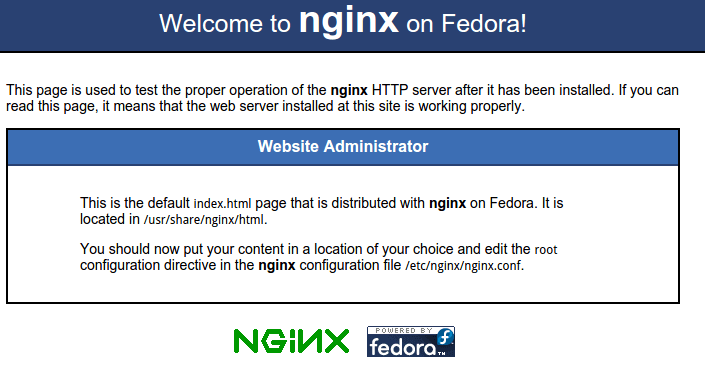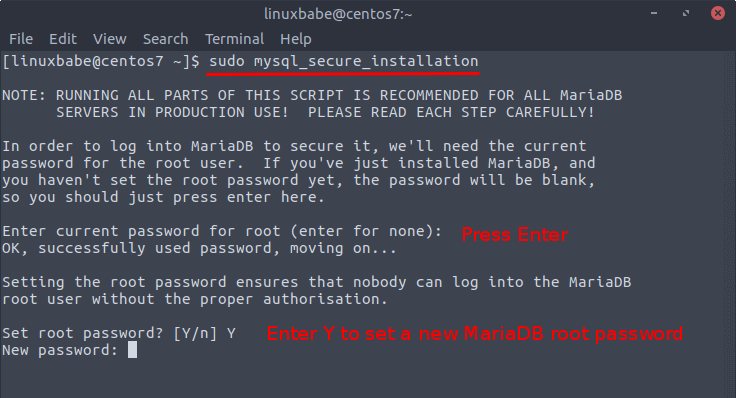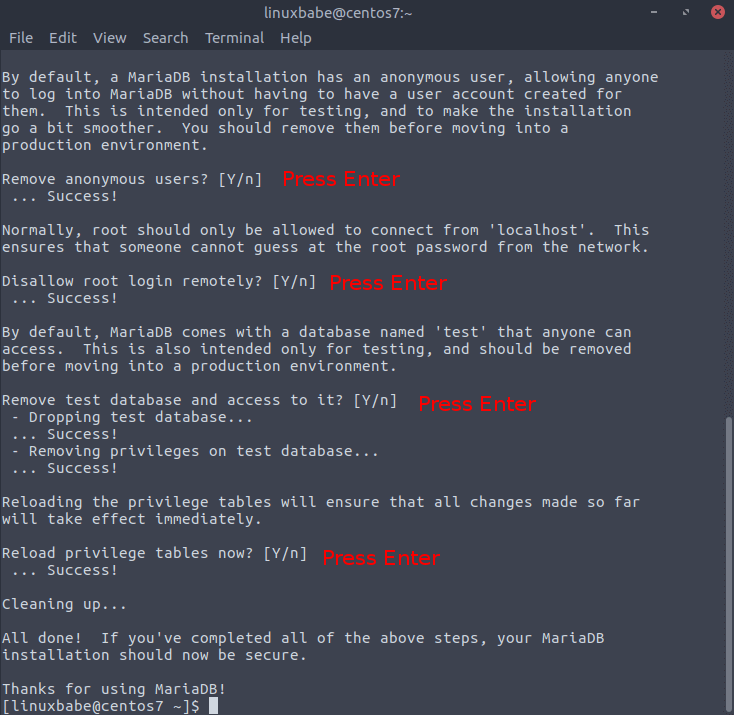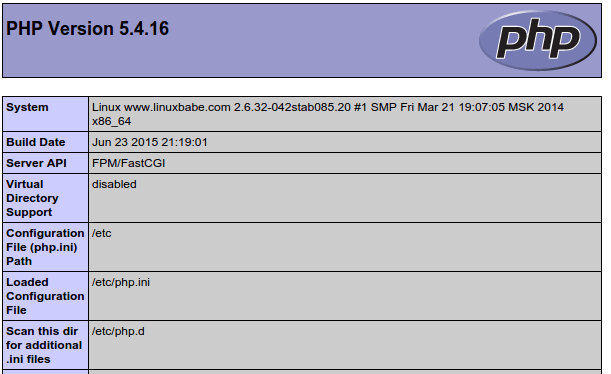Install LEMP stack (Nginx, MariaDB, PHP-FPM) on CentOS7 Step by Step Guide
LEMP stands for Linux, Nginx (Pronounced engine X), MySQL/MariaDB and PHP. It enables a server to host dynamic website and web apps. In this tutorial I will show you how to install LEMP stack on CentOS 7 Server. I choose to install MariaDB as the database server instead of MySQL.
Install Nginx on CentOS7 From EPEL
Nginx is a fast web server compared to Apache and becomes more popular these days. In order to install Nginx on CentOS 7, we need to add the EPEL repository using the following command. EPEL stands for Extra Packages for Enterprise Linux.
sudo yum install epel-release -y
Type your password. Now that the repository is added, it’s time to install Nginx:
sudo yum install nginx -y
After Nginx is installed, we need to start it.
sudo systemctl start nginx
Enable Nginx to start at system boot time.
sudo systemctl enable nginx
Check if it’s running:
systemctl status nginx
Sample output:
● nginx.service - The nginx HTTP and reverse proxy server Loaded: loaded (/usr/lib/systemd/system/nginx.service; enabled; vendor preset: disabled) Active: active (running) since Mon 2018-09-24 08:36:31 UTC; 1min 19s ago Main PID: 13692 (nginx) CGroup: /system.slice/nginx.service ├─13692 nginx: master process /usr/sbin/nginx └─13693 nginx: worker process
Check Nginx version:
[linuxbabe@centos7 ~]$ nginx -v nginx version: nginx/1.12.2
Type your server IP address in your web browser, if you see the following, then Nginx is correctly installed.

You can find you server public IP address using the following command:
ip address
or
curl http://icanhazip.com
Your server firewall may have disabled public access to port 80. To allow public access, we tell iptables firewall to accept traffic to port 80 with the following command.
sudo iptables -I INPUT -p tcp --dport 80 -j ACCEPT
Now your server can host static html files, but in order to server a dynamic website, we need to install MariaDB and PHP.
Install MariaDB on CentOS 7
MariaDB is a drop-in replacement for MySQL. Install it using following command:
sudo yum install mariadb-server mariadb -y
After it’s installed, we need to start it.
sudo systemctl start mariadb
Enable MariaDB to start at system boot time.
sudo systemctl enable mariadb
Check status:
systemctl status mariadb
outputs:
● mariadb.service - MariaDB database server Loaded: loaded (/usr/lib/systemd/system/mariadb.service; enabled; vendor preset: disabled) Active: active (running) since Mon 2018-09-24 08:48:46 UTC; 23s ago Main PID: 13970 (mysqld_safe) CGroup: /system.slice/mariadb.service ├─13970 /bin/sh /usr/bin/mysqld_safe --basedir=/usr
Check version:
[linuxbabe@centos7 ~]$ mysql --version mysql Ver 15.1 Distrib 5.5.60-MariaDB, for Linux (x86_64) using readline 5.1
Now we need to run the security script.
sudo mysql_secure_installation
When the script ask you for the current root password, just leave it blank and press enter. Then enter Y and set a root password.

After you set the root password, you can simply press enter to answer all of other questions. (Note that the letter Y is capitalized, which means it’s the default answer.)

Now let’s move on to the PHP part.
Install PHP-FPM on CentOS7
Install PHP and related packages using the following command:
sudo yum install php php-mysql php-fpm php-gd php-xml php-mbstring -y
Now edit the php-fpm config file:
sudo nano /etc/php-fpm.d/www.conf
Find the following line:
listen = 127.0.0.1:9000
change it to this:
listen = /var/run/php-fpm/php-fpm.sock
then find the following two lines:
;listen.owner = nobody ;listen.group = nobody
remove the preceding semicolons. Lastly, change the user and group value from “apache” to “nginx”:
user = nginx group = nginx
Once you save and close the file, start the PHP Processor:
sudo systemctl start php-fpm
Next, enable php-fpm to start on system boot.
sudo systemctl enable php-fpm
Configure Nginx Virtual Host
Create a new virtual host file in /etc/nginx/conf.d directory
sudo nano /etc/nginx/conf.d/example.com.conf
Add the following lines to it. Replace www.example.com and example.com with your own domain. Don’t forget to set A record for your domain name.
server {
listen 80;
server_name www.example.com example.com;
root /usr/share/nginx/html;
index index.php index.html index.htm;
location / {
try_files $uri $uri/ /index.php$query_string;
}
error_page 404 /404.html;
error_page 500 502 503 504 /50x.html;
location = /50x.html {
root /usr/share/nginx/html;
}
location ~ \.php$ {
try_files $uri =404;
fastcgi_pass unix:/var/run/php-fpm/php-fpm.sock;
fastcgi_index index.php;
fastcgi_param SCRIPT_FILENAME $document_root$fastcgi_script_name;
include fastcgi_params;
}
}
Save and close the file. then reload nginx:
sudo systemctl reload nginx
You can add additional virtual host files to host multiple website on a single server.
Test PHP Processing
Create a info.php file in the web root directory:
sudo nano /usr/share/nginx/html/info.php
Put the following text into the file
<?php phpinfo(); ?>
Save and close it. Then visit you newly created file by typing the following in your browser:
http://example.com/info.php
or
your ip address/info.php
If you will see something like in the following screenshot, then your PHP is working correctly.

This file is for testing only. For security reasons you can now remove it using the following command:
sudo rm /usr/share/nginx/html/info.php
Now you have LEMP installed, you may wonder what you should do next. Well, you can install a WordPress or Drupal website on top of your LEMP stack. That’s just what I will show you in the next tutorial.



Hi,
Thank you for your guide.
All works properly instead of php-fpm. After installing and configuring php-fpm
I got an error:
“Something has triggered an error on your website. This is the default error page for nginx that is distributed with Fedora. It is located /usr/share/nginx/html/50x.html
You should customize this error page for your own site or edit the error_page directive in the nginx configuration file /etc/nginx/nginx.conf. ”
Still unable to fix it.